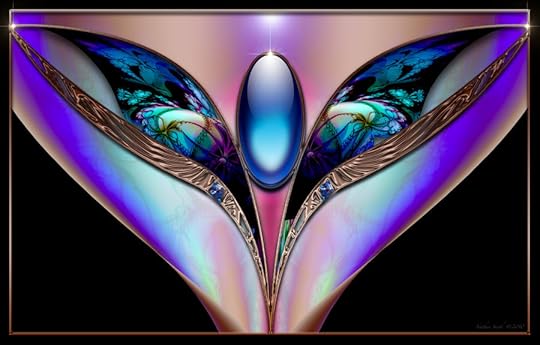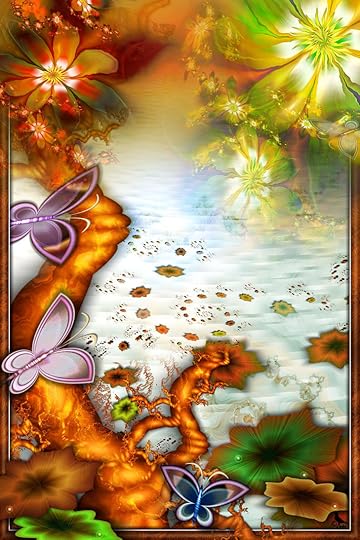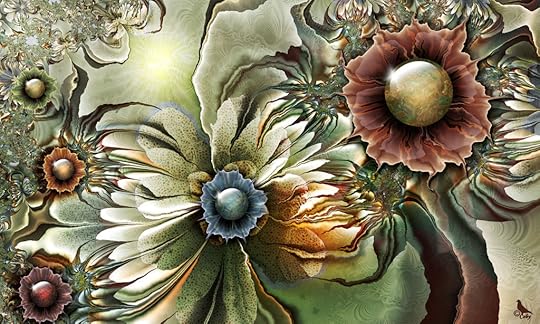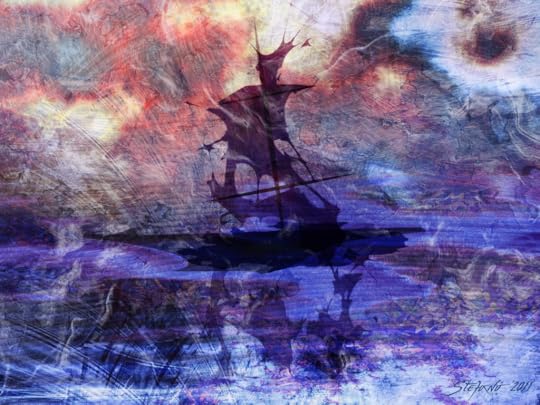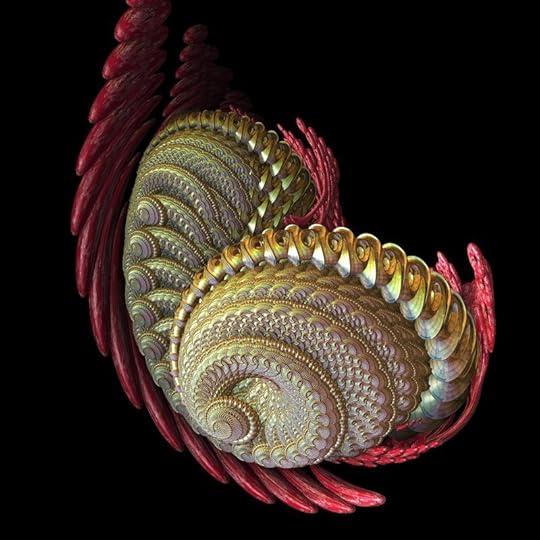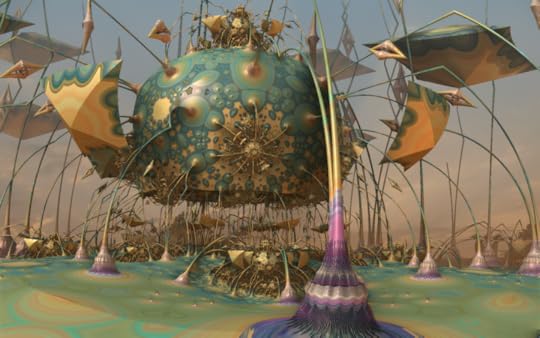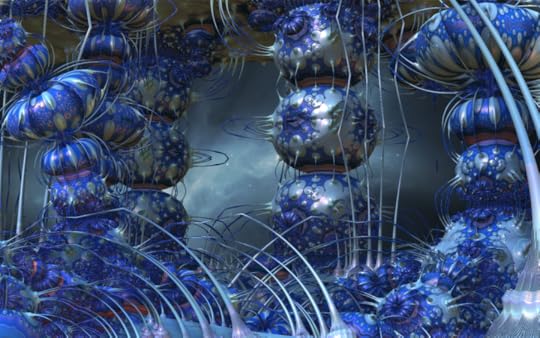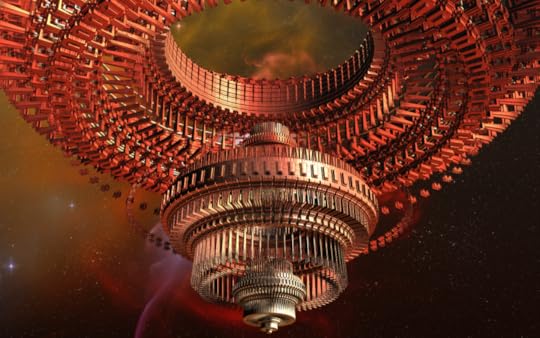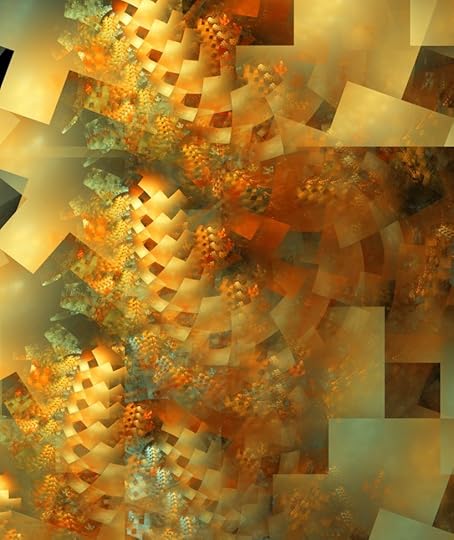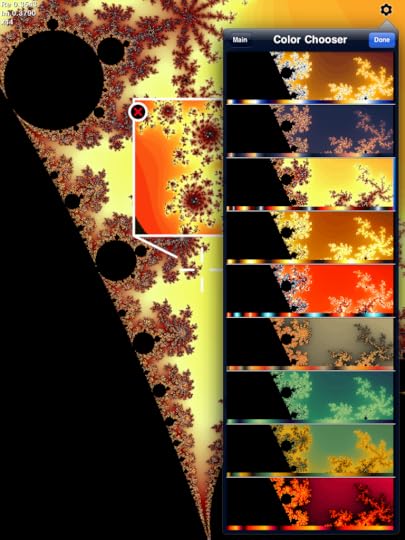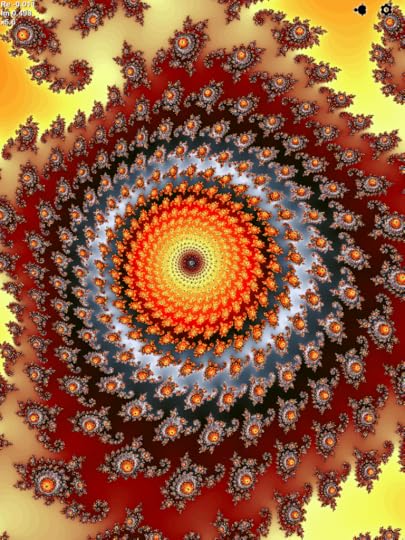Art Lovers discussion
Art Lovers News Corner
>
Fractals
date newest »
newest »
 newest »
newest »
message 1:
by
Aloha
(new)
Nov 17, 2011 02:26AM
 I'm a member of DeviantArt. They sent me a link to a discussion as to whether fractal art is art. Looking at some of the work, I agree that it is art. I don't think it's art if there's no thought behind it, but only letting the computer do the work, but I do agree that it's art if you use the computer as a tool to reach your goal. I saw one comment that said that if it can't be duplicated outside of the computer, it's not art. I disagree with that. I think that the computer is just another tool. It is the process of mental creation that defines art. That is why you don't have to know how to paint and draw to make art, although it would be great to add that to your arsenal of art tools. Following are links to various fractal artists.
I'm a member of DeviantArt. They sent me a link to a discussion as to whether fractal art is art. Looking at some of the work, I agree that it is art. I don't think it's art if there's no thought behind it, but only letting the computer do the work, but I do agree that it's art if you use the computer as a tool to reach your goal. I saw one comment that said that if it can't be duplicated outside of the computer, it's not art. I disagree with that. I think that the computer is just another tool. It is the process of mental creation that defines art. That is why you don't have to know how to paint and draw to make art, although it would be great to add that to your arsenal of art tools. Following are links to various fractal artists.
reply
|
flag
 Here is the link to the discussion as to whether fractal art is art:
Here is the link to the discussion as to whether fractal art is art:http://hq.deviantart.com/journal/The-...
 I think I posted a good representative of the varying possibilities of fractal art. Looking at the range, I think fractal art is indeed art.
I think I posted a good representative of the varying possibilities of fractal art. Looking at the range, I think fractal art is indeed art.
 "Fractal art is a form of algorithmic art created by calculating fractal objects and representing the calculation results as still images, animations, and media. Fractal art developed from the mid 1980s onwards. It is a genre of computer art and digital art which are part of new media art.
"Fractal art is a form of algorithmic art created by calculating fractal objects and representing the calculation results as still images, animations, and media. Fractal art developed from the mid 1980s onwards. It is a genre of computer art and digital art which are part of new media art. Fractal art is not drawn or painted by hand. It is usually created indirectly with the assistance of fractal-generating software, iterating through three phases: setting parameters of appropriate fractal software; executing the possibly lengthy calculation; and evaluating the product. In some cases, other graphics programs are used to further modify the images produced. This is called post-processing. Non-fractal imagery may also be integrated into the artwork.
Fractal art could not have been developed without the computer because of the calculative capabilities they provide. Fractals are generated by applying iterative methods to solving non-linear equations or polynomial equations. Fractals are any of various extremely irregular curves or shapes for which any suitably chosen part is similar in shape to a given larger or smaller part when magnified or reduced to the same size."
http://en.wikipedia.org/wiki/Fractal_art
 Thank you, Aloha. Whether some attest that it is or isn't art, one can't deny that it can just as well be beautiful!
Thank you, Aloha. Whether some attest that it is or isn't art, one can't deny that it can just as well be beautiful!Myself, I agree with you, I believe that it is art. Like you said, it is the imagination, the image/visual or "mental creation" in the artists mind that is behind the work that makes it art. The computer can't decide what it is supposed to look like. This is obvious from the variety of styles you have exhibited above. Each artist has his or her own view.
 The Fractal Art Manifesto
The Fractal Art ManifestoAs stated by Kerry Mitchell in The Fractal Art Manifesto, "Fractal Art is a subclass of two-dimensional visual art, and is in many respects similar to photography—another art form that was greeted by skepticism upon its arrival. Fractal images typically are manifested as prints, bringing fractal artists into the company of painters, photographers, and printmakers. Fractals exist natively as electronic images. This is a format that traditional visual artists are quickly embracing, bringing them into Fractal Art's digital realm. Generating fractals can be an artistic endeavor, a mathematical pursuit, or just a soothing diversion. However, Fractal Art is clearly distinguished from other digital activities by what it is, and by what it is not." According to Mitchell, fractal art is not computerized art, lacking in rules, unpredictable, nor something that any person with access to a computer can do well. Instead, fractal art is expressive, creative, and requires input, effort, and intelligence. Most importantly, "fractal art is simply that which is created by Fractal Artists: ART."
 For anyone wanting to play with this, here is a site that has free programs for Windows and Macs, and online generators.
For anyone wanting to play with this, here is a site that has free programs for Windows and Macs, and online generators.http://fractalarts.com/ASF/download.html
Here is the link to instructions:
http://fractalarts.com/ASF/Tutor1.html
Good luck! See whether you can create one these beauties that was posted. LOL
 YouTube video that explains about fractals in an easy to understand way. Great to show to your kids.
YouTube video that explains about fractals in an easy to understand way. Great to show to your kids.http://www.youtube.com/watch?v=bE2EiI...
 Great video of 3D fractal:
Great video of 3D fractal:http://www.youtube.com/watch?v=E91yxk...
I spent all my spare time yesterday trying out the various fractal applications. It is fun, but I have a way to go in my learning curve.
 Have fun with that, Ed. I went app crazy and got some for the iPad and for the Mac. Of the ones that were up there, I downloaded Mandelbulb3D since I have MandelbulbHD for the iPad. I also downloaded Xaos. I purchased FractalMaker for the iPad. They have it for the Mac, but I'm holding off on that to see how the iPad one works. I have to play around with each programs and see what each does. I have a long way to go before I can do anything with so much control as what these artists did. Right now, I can only do pretty little patterns with little control. But, as you know, Ed, the process of discovery is most of the fun.
Have fun with that, Ed. I went app crazy and got some for the iPad and for the Mac. Of the ones that were up there, I downloaded Mandelbulb3D since I have MandelbulbHD for the iPad. I also downloaded Xaos. I purchased FractalMaker for the iPad. They have it for the Mac, but I'm holding off on that to see how the iPad one works. I have to play around with each programs and see what each does. I have a long way to go before I can do anything with so much control as what these artists did. Right now, I can only do pretty little patterns with little control. But, as you know, Ed, the process of discovery is most of the fun.
 Aloha wrote: "Have fun with that, Ed. I went app crazy and got some for the iPad and for the Mac. Of the ones that were up there, I downloaded Mandelbulb3D since I have MandelbulbHD for the iPad. I also downl..."
Aloha wrote: "Have fun with that, Ed. I went app crazy and got some for the iPad and for the Mac. Of the ones that were up there, I downloaded Mandelbulb3D since I have MandelbulbHD for the iPad. I also downl..."Yes. I can't emphasize enough the process of discovery in combination with selection as part of the creative process. Some people get hung up on the idea of starting out with an "intent". You can go exploring, and if you are good at selecting the best things, that becomes your intent. It's certainly a big part of photography, but it's also part of any art that involves improvisation. For example many of the color field stain painters did the shapes and colors first, and then chose the portion that was to be the composition second, marking little tick marks and then later cutting and stretching to match.
Thus far I have just played around with some palettes and croppings of some particular fractal formulas. I liked that Xeos gave me the option to modify the formulas (I know a lot of math), although I was having too much fun to read the manual yet.
I am going to take some parts and incorporate then into paintings using image transfer.
 By the way, I think I posted this in a different forum, but one of my online friends is a digital and fractal artist.
By the way, I think I posted this in a different forum, but one of my online friends is a digital and fractal artist. She says: "Just like traditional art mediums- elements and principles of art still apply. Form, line, shape, color, texture, space, value, composition, emphasis, balance, variety, harmony, movement, rhythm, proportion, perspective and unity are still the foundation of this art form. The creative process and how each work is approached is the same. And for many digital artists each work begins with a drawing in a sketch book."
Science and technology are not that different from art. Leonardo Davinci, MC Escher, and Benoit Mandelbrot knew this. It is time for the rest of the world to catch up."
Here's a link to Pam's site:
http://pamrenovato.com/
 I find it stagnating to stick to a rule. I get a head rush when I explore and follow something just because I'm enthusiastic about it. I know it's 5% inspiration and 95% perspiration, but the 5% is so much fun! I love new mental and artistic territories.
I find it stagnating to stick to a rule. I get a head rush when I explore and follow something just because I'm enthusiastic about it. I know it's 5% inspiration and 95% perspiration, but the 5% is so much fun! I love new mental and artistic territories.The easy apps that were designed for people who only want to see the pretty stuff first is too limiting. I'm going to have to go for apps that allow me to input formulas for variety and control.
Thank you, Ed, for posting the link to Pam's site. It is terrific. I bookmarked it.
 I now have the book The Colours of Infinity: The Beauty and Power of Fractals. Scanning through it, it looks like a great overview for the layman with beautiful illustrations. I'm looking forward to reading this book. I also found the video, Fractals: The Color of Infinity by Arthur C. Clarke and Benoit Mandelbrot that is an accompaniment to this book. That looks terrific, too. I can't wait to watch it this weekend.
I now have the book The Colours of Infinity: The Beauty and Power of Fractals. Scanning through it, it looks like a great overview for the layman with beautiful illustrations. I'm looking forward to reading this book. I also found the video, Fractals: The Color of Infinity by Arthur C. Clarke and Benoit Mandelbrot that is an accompaniment to this book. That looks terrific, too. I can't wait to watch it this weekend.
 Here is the Amazon link to the video for info., but I found it elsewhere.
Here is the Amazon link to the video for info., but I found it elsewhere.http://www.amazon.com/Fractals-Infini...
 Aloha wrote: "Here is the Amazon link to the video for info., but I found it elsewhere.
Aloha wrote: "Here is the Amazon link to the video for info., but I found it elsewhere.http://www.amazon.com/Fractals-Infini..."
Somewhere on this forum, I posted the links to it on YouTube. I think in a topic like math and art....
 I think the thread you started awhile ago, Ed, could relate somewhat to this topic also. Is this the one you're talking about?
I think the thread you started awhile ago, Ed, could relate somewhat to this topic also. Is this the one you're talking about?Geometry in Art
http://www.goodreads.com/topic/show/5...
 Thanks, Heather and Ed. That is exactly the video I now have. Here is the link so you don't have to search the whole thread:
Thanks, Heather and Ed. That is exactly the video I now have. Here is the link so you don't have to search the whole thread:http://www.youtube.com/watch?v=qB8m85...
 This is a great video of the journey across the Mandelbrot set, with great music and visuals in 720p HD.
This is a great video of the journey across the Mandelbrot set, with great music and visuals in 720p HD.http://www.youtube.com/watch?v=F_nfHY...
 Aloha wrote: "I find it stagnating to stick to a rule. I get a head rush when I explore and follow something just because I'm enthusiastic about it. I know it's 5% inspiration and 95% perspiration, but the 5% ..."
Aloha wrote: "I find it stagnating to stick to a rule. I get a head rush when I explore and follow something just because I'm enthusiastic about it. I know it's 5% inspiration and 95% perspiration, but the 5% ..."Aloha wrote: "This is a great video of the journey across the Mandelbrot set, with great music and visuals in 720p HD.
http://www.youtube.com/watch?v=F_nfHY..."
I just played with Xaos to see what would happen to the Mandelbrot set if I changed the exponent (the "2" in the formula). Some time, when I get the time to do it, I'll post them. (I won't go into the math unless somebody asks.)
In general, it starts dividing itself up, by the time it reaches 64 it gets to be a wriggly circle with a whole bunch of offshoots attached (maybe about 64 bud universes). That's a little boring until you zoom in, and then it is quite gorgeous.
On another note, I experimented with using transfer with a fractal on a miniature (2" X 2"). I painted on it quite a bit, it no longer looks fractal-y, but it makes for a whole bunch of detail.
 Well, I am now on vacation, so I get to do it. These were more of a systematic experiment, varying one at a time. I didn't try to do anything extra with the filters or the palettes. Even so they are pretty.
Well, I am now on vacation, so I get to do it. These were more of a systematic experiment, varying one at a time. I didn't try to do anything extra with the filters or the palettes. Even so they are pretty.Here's the link on Picassa, with the formulas:
https://picasaweb.google.com/10885649...
I'll include the individual ones here. They form a series as I change one variable. But if you go to the link you can zoom them a bit.






Here's a detail of the above image:

 Wow! That's a great way to learn, Ed. I'm randomly punching in this and that. I get pretty pictures, but no control. Your link does not work. Thank you. I'll post mine as soon as I get more control and sense out of them beyond just making random pretty pictures.
Wow! That's a great way to learn, Ed. I'm randomly punching in this and that. I get pretty pictures, but no control. Your link does not work. Thank you. I'll post mine as soon as I get more control and sense out of them beyond just making random pretty pictures.
 I've been playing in an iPad app. called Fractile Plus. I love it. It's easy, intuitive, has little processing time, and requires no input of equations. I recommend it for anyone who wants to have fun with fractals but do not want to deal with the mathematics of it. Of course, you have to have an iPad. Basically, it starts with a Mandelbrot, which has a magnifier that sees each area you focus as a Julia set. You can zoom in and out very quickly with taps. When you tap inside of the magnifier, it converts into the Julia set, which you can also zoom in and out.
I've been playing in an iPad app. called Fractile Plus. I love it. It's easy, intuitive, has little processing time, and requires no input of equations. I recommend it for anyone who wants to have fun with fractals but do not want to deal with the mathematics of it. Of course, you have to have an iPad. Basically, it starts with a Mandelbrot, which has a magnifier that sees each area you focus as a Julia set. You can zoom in and out very quickly with taps. When you tap inside of the magnifier, it converts into the Julia set, which you can also zoom in and out.You start off with something like this:

 Then you can zoom into the Mandelbrot. This is a different color scheme, but I didn't take a snapshot of the beginning of this one.
Then you can zoom into the Mandelbrot. This is a different color scheme, but I didn't take a snapshot of the beginning of this one.
 Of course, when I decided to post all the pictures in one post, my computer freezes up, making me lose what I just inputted and disturbing all the uploading of my files up into Rapidshare for back up. *sigh* Okay, to continue but in individual posts, just in case.
Of course, when I decided to post all the pictures in one post, my computer freezes up, making me lose what I just inputted and disturbing all the uploading of my files up into Rapidshare for back up. *sigh* Okay, to continue but in individual posts, just in case.
 After finding the Julia set I like. Picture is in Post 36. I clicked into the magnifier. This takes me to the Julia set.
After finding the Julia set I like. Picture is in Post 36. I clicked into the magnifier. This takes me to the Julia set.
 Maximal zooming in. You can see how much by the bottom most number, in the upper left of the picture. I think I might have taken a screen shot too soon before it finished processing, because it's a little blurry on the right side. I also have the option of exporting to a maximum resolution of 1991 X 2654 pixels, which is usable for doing graphics.
Maximal zooming in. You can see how much by the bottom most number, in the upper left of the picture. I think I might have taken a screen shot too soon before it finished processing, because it's a little blurry on the right side. I also have the option of exporting to a maximum resolution of 1991 X 2654 pixels, which is usable for doing graphics.
 Ed, since you have a friend who makes fractal art, do they use what they generate only as a base to modify into what they like? It's not purely fractal? Looking at the varying art work, can they create them with only generated fractals? I don't see how that can be done.
Ed, since you have a friend who makes fractal art, do they use what they generate only as a base to modify into what they like? It's not purely fractal? Looking at the varying art work, can they create them with only generated fractals? I don't see how that can be done.
 Those are really neat, Ed and Aloha! I don't have an iPad, Sometime I would like to have a try at it! Thank you both for sharing!
Those are really neat, Ed and Aloha! I don't have an iPad, Sometime I would like to have a try at it! Thank you both for sharing!
 Aloha wrote: "Ed, since you have a friend who makes fractal art, do they use what they generate only as a base to modify into what they like? It's not purely fractal? Looking at the varying art work, can they ..."
Aloha wrote: "Ed, since you have a friend who makes fractal art, do they use what they generate only as a base to modify into what they like? It's not purely fractal? Looking at the varying art work, can they ..."I think she modifies it in various ways, and she uses a lot of different kinds of software. She also uses Poser to generate figures and does all kinds of filters and modifications. She also cranks of the settings on all the processing for the most complxity, so her images often take many hours to render.
Aloha, these are gorgeous.
By the way, Heather, there are free programs out there for the PC and Mac, they may not be as good as the one on the iPad, but you can have a lot of fun zooming around with them.


